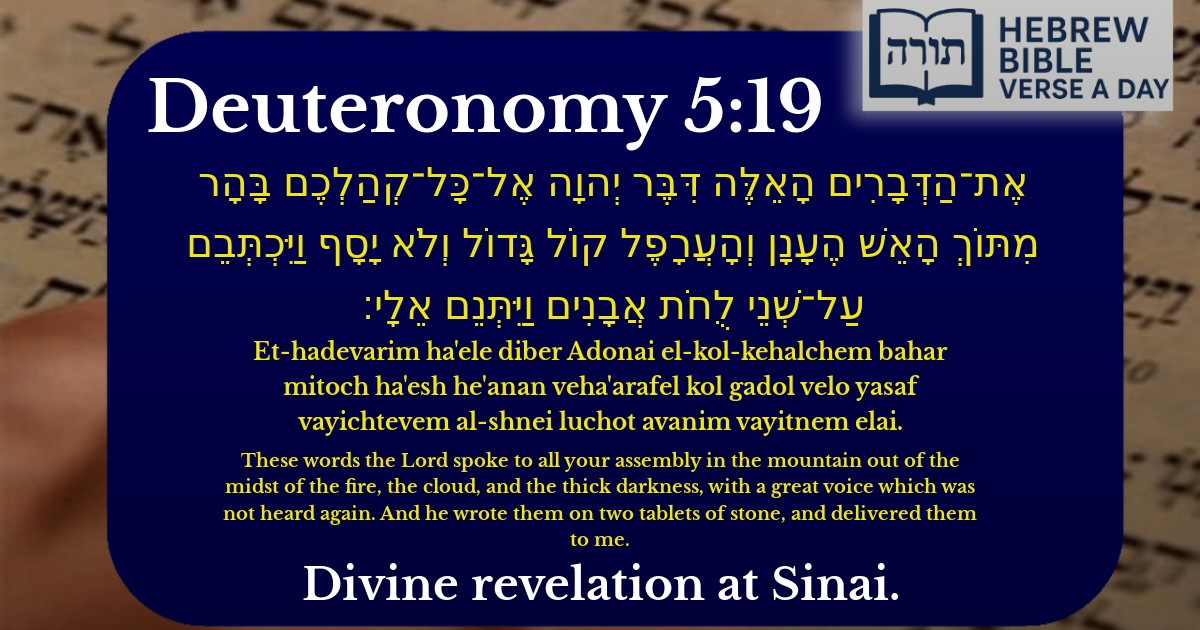Frequently Asked Questions
Q: What does Deuteronomy 5:19 mean?
A: Deuteronomy 5:19 describes how Hashem spoke the Ten Commandments to the entire Jewish people at Mount Sinai amidst fire, cloud, and thick darkness. The verse emphasizes the unique, awe-inspiring revelation where Hashem's voice was heard directly by the nation, and how He inscribed these commandments on the Two Tablets of Stone and gave them to Moshe (Moses). Rashi explains that the 'great voice' was powerful yet clear, showing the divine nature of the Torah's transmission.
Q: Why is the giving of the Ten Commandments at Mount Sinai important?
A: The giving of the Ten Commandments at Mount Sinai is the foundational event in Judaism, marking the formal covenant between Hashem and the Jewish people. According to the Rambam (Maimonides), this moment established the Torah as divine law, binding for all generations. The Talmud (Makkot 24a) teaches that the Ten Commandments encapsulate all 613 mitzvot (commandments), making this event central to Jewish faith and practice.
Q: What can we learn from the way Hashem gave the Torah at Mount Sinai?
A: The Midrash (Shemot Rabbah 29:4) teaches that Hashem gave the Torah amidst fire, cloud, and darkness to show that Torah must be approached with awe, humility, and reverence. The fact that all of Israel heard Hashem's voice directly (as stated in this verse) teaches that every Jew has a personal connection to Torah. Additionally, the tablets being made of stone symbolize the eternal and unbreakable nature of the covenant.
Q: How does the revelation at Mount Sinai apply to us today?
A: The revelation at Mount Sinai is not just a historical event but a living covenant. The Talmud (Shabbat 146a) teaches that every Jewish soul, past and future, was present at Sinai. This means that the commandments given then are still binding today. Orthodox Judaism views the Torah as eternally relevant, and the experience at Sinai reminds us to study and observe mitzvot with the same awe and commitment as our ancestors.
Q: Why were the Ten Commandments written on stone tablets?
A: Rashi (on Exodus 31:18) explains that the stone tablets symbolize the permanence of the Torah—just as stone is durable, so too are Hashem's commandments everlasting. The Talmud (Bava Batra 14a) also notes that the tablets were made by Hashem Himself, emphasizing their divine origin. The two tablets may also represent the two categories of mitzvot: between man and Hashem, and between man and his fellow.


The Divine Revelation at Sinai
The verse describes the unparalleled revelation at Mount Sinai, where Hashem spoke directly to the entire nation of Israel. Rashi (Devarim 5:19) emphasizes that this was a unique event in history—where the Divine Presence was revealed to an entire nation, not just to an individual prophet. The mention of "the fire, the cloud, and the thick darkness" symbolizes the awe-inspiring nature of the revelation, as explained by the Ramban (Devarim 4:11), who notes that these elements represent the concealment and revelation of the Divine Presence simultaneously.
The Eternal Voice
The phrase "with a great voice which was not heard again" is interpreted by the Talmud (Berachot 22a) to mean that the voice of Hashem at Sinai had no echo—a supernatural phenomenon demonstrating its divine origin. The Sforno (Devarim 5:19) adds that this voice was singular and never repeated in the same way, underscoring the uniqueness of Matan Torah (the Giving of the Torah).
The Writing on the Tablets
The verse concludes with the giving of the Luchot (tablets), which Rambam (Hilchot Yesodei HaTorah 1:8) teaches were inscribed by Hashem Himself. The Midrash (Shemot Rabbah 47:2) elaborates that the letters were carved through the stone miraculously, readable from both sides. This symbolizes the Torah's accessibility and clarity to all who seek it.